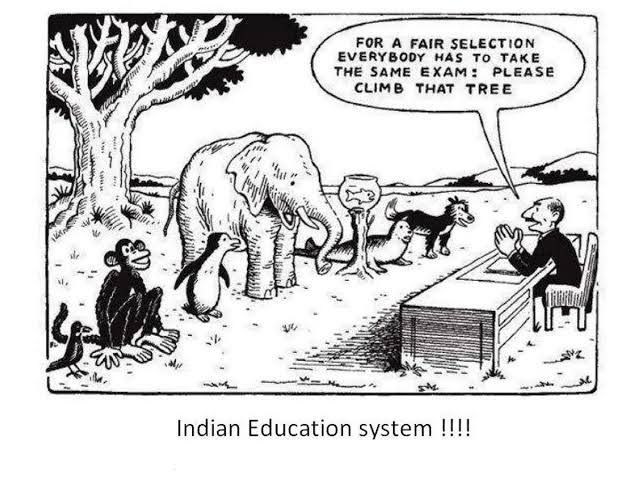An Uncomfortable Truth About the Flaws and How to Fix Indian Education System

Indian education system is plagued by numerous loopholes that not only stifle creativity but also perpetuate inequality and corruption. While the system is intended to promote holistic education, it often ends up being a breeding ground for mediocrity, where merit takes a backseat to money, caste, and connections. This blog delves into some of the worst loopholes in the Indian education system, backed by real incidents, and provides suggestions on how these flaws can be addressed.
The Obsession with Marks: A Narrow Definition of Success

The Indian education system is notorious for its unhealthy obsession with marks and grades. This focus on rote learning and exam scores reduces education to a mere numbers game, where a student’s worth is judged solely by their percentage.
Example: Kota, Rajasthan, the coaching hub of India, has become a pressure cooker for students aspiring to crack competitive exams like IIT-JEE and NEET. In recent years, several cases of student suicides have surfaced, where students, unable to cope with the immense pressure, took their own lives. These tragic incidents highlight the system’s failure to recognize the human cost of its relentless pursuit of academic excellence.
Suggestion: A shift from rote learning and exam-based evaluation to a more comprehensive assessment approach is crucial. Methods like project-based learning, continuous assessment, and skill development should be emphasized to reduce the pressure on students and encourage holistic growth.
Nepotism and Corruption: The Unspoken Reality

In many parts of India, merit often takes a backseat to nepotism and corruption. Wealthy families and those with the right connections often secure seats in prestigious institutions for their children, sidelining deserving candidates.
Example: In Kota, where thousands of students flock to prepare for competitive exams, the commercialization of education is rampant. Coaching centers charge exorbitant fees, creating an environment where only those who can afford it have access to quality preparation. Moreover, instances of seats being sold in medical and engineering colleges have been reported, where candidates with deep pockets but little merit gain admission over more deserving students.
Suggestion: Strict regulations need to be enforced to curb the commercialization of education. The government should monitor coaching centers, ensure transparency in admissions, and impose heavy penalties on institutions involved in corrupt practices. Additionally, merit-based scholarships should be expanded to give deserving students a fair chance, regardless of their financial background.
Caste-Based Discrimination: A Persistent Blight

The caste system, though constitutionally abolished, still rears its ugly head in the Indian education system. Reservations, intended to uplift historically marginalized communities, have often been exploited, leading to resentment and furthering inequality.
Example: In many competitive exams, reserved category students are often stereotyped and looked down upon by their peers and sometimes even by the faculty. This discrimination not only affects the mental health of these students but also hinders their academic performance. Additionally, there have been instances where deserving students from general categories miss out on seats due to the reservation system, sparking debates on its fairness.
Suggestion: While reservations are necessary to ensure representation, the system needs to be re-evaluated to ensure that it benefits those who truly need it. The focus should be on providing quality education to all, irrespective of caste, from the primary level itself, so that by the time students reach higher education, the playing field is more level.
The Seat Crunch: More Students, Fewer Opportunities

One of the most significant challenges in the Indian education system is the massive competition for a limited number of seats in prestigious institutions. Every year, millions of students vie for a few thousand seats in IITs, AIIMS, and other top colleges, leading to cutthroat competition and immense stress.
Example: The IIT-JEE exam, one of the toughest in the world, sees over a million students competing for around 16,000 seats. This means that even students who score 90% or above may not secure a seat. The sheer disparity between the number of aspirants and the available seats highlights the inadequacy of the system to cater to the growing demand for quality education.
Suggestion: The government needs to expand the number of quality institutions to accommodate more students. Additionally, vocational training and skill-based education should be promoted as viable alternatives to traditional degree programs. This would not only reduce the pressure on students but also help in addressing the employability crisis in the country.
Commercialization of Education: When Learning Becomes a Business

Education, a fundamental right, has become a lucrative business in India. Private schools and coaching centers charge exorbitant fees, making quality education accessible only to the wealthy. This commercialization has widened the gap between the rich and the poor, with students from underprivileged backgrounds often receiving substandard education.
Example: Kota’s coaching industry, which prepares students for competitive exams, generates billions of rupees annually. However, the focus on profits over pedagogy has led to a system where students are treated as commodities. The lack of regulation in fee structures has made it impossible for economically weaker students to access these facilities, further perpetuating inequality.
Suggestion: The government must regulate the fees charged by private institutions and coaching centers. Additionally, more public schools and colleges with high standards should be established to ensure that all students, regardless of their financial status, have access to quality education. Scholarships and financial aid programs should also be expanded to support economically disadvantaged students.
A Call to Action
The flaws in India’s education system are numerous and deeply entrenched, but they are not insurmountable. By acknowledging these loopholes and taking decisive action to address them, we can build an education system that not only produces knowledgeable individuals but also empowers them to be creative, critical thinkers capable of driving the nation forward.
The time for reform is now. Policymakers, educators, and society at large must work together to dismantle the outdated structures that hold our education system back. Only then can we hope to provide our future generations with the quality education they deserve—a system that nurtures their minds, fosters their talents, and prepares them for the challenges of tomorrow.
Write with us✍?
TeamUgtWorld warmly welcomes everyone! If you have something on your mind that you’d like to write about, we invite you to publish your thoughts on our platform @Ugtworld. To learn more, please click on the link provided below.


